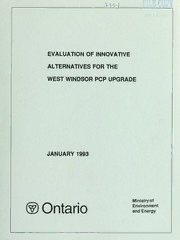
Evaluation of innovative alternatives for the West Windsor PCP upgrade PDF
Preview Evaluation of innovative alternatives for the West Windsor PCP upgrade
EVALUATION OF INNOVATIVE ALTERNATIVES FOR THE WEST WINDSOR PCP UPGRADE JANUARY 1993 ® Ministryof Ontario Environment andEnergy ISBN0-7778-0821-8 EVALUATIONOFINNOVATIVEALTERNATIVES FORTHEWESTWINDSORPCPUPGRADE JANUARY 1994 Cettepublicationtechnique n'estdisponiblequ'enanglais. Copyright: Queen'sPrinterforOntario, 1994 Thispublication maybereproduced fornon-commercialpurposes withappropriateattribution. FIBS2334 ACKNOWLEDGEMENT The Ontario Ministry of Environment and Energy thanks the City of Windsor for its permission to publish and distribute this report to the public. DISCLAIMER This report was prepared for the City of Windsor as part of a cooperative project between the City, Ministry of Environment and Energy and Environment Canada. The views and ideas expressed in this report are those of the author and do not necessarily reflect the views and policies of the funding agencies, nor does mention of trade names or coinmercial products constitute endorsement or recommendation for use. Any person who wisheç to republish part or all of this report should apply for permission to do so to the City of Windsor, Department of Public Works, Pollution Control, 4155 Objibway Parkway, Windsor, Ontario, N9A 6S1 (519-253-7218). EXECUTIVE SUMMARY Twenty-fourOntario municipal primarywastewater treatment plants borderingonthe Great Lakes will be required to provide Best Available Treatment Economically Achievable (BATEA) in the near future. At the least, these plants will require secondarybiologicaltreatment. TheCityofWindsor'sWestWindsorPollutionControl Plant (PCP) is the largest ofthese facilities and it is expected that the upgrade will require a large capital and operating investment from the City. The West Windsor PCP'saveragehydraulicdesigncapacityis 159,000m^/danditspeakhydrauliccapacity is350,000m^/d. TheexistingWestWindsorPCPuseschemicalprecipitationandflocculationtoremove phosphorus and obtain an enhanced primary effluent. The City, expecting to be mandated to provide secondary treatment or BATEA, has investigated alternative treatment processes that would use the existing enhanced primary effluent to the greatest degree possible, while meeting the future plant's effluent requirements. Alternativetreatmentoptionswouldalsohavetobecosteffective. Theplanttreateda yearly average wastewater flow of 116,000, 118,000, 139,000 and 120,000 mVd from 1988to 1991. Basedonoveralldatafromthepast4V3year,theplantremoved 82and 64 percentofsuspended solids (SS) and total BOD5. The plant has met its monthly effluenttotalphosphorus(TP)requirementof1.0mg/Lforallbutonemonthoverthe same473yearperiod. Theeffluenthadaverageconcentrationsof24,36and0.6mg/L forSS,totalBOD5andTPforthe4V3yearperiod. TableE.lsummarizesthehistorical performanceoftheWestWindsorPCP. The plant obtains enhanced primarytreatment through the addition offerric chloride or alum forprecipitation and coagulation, in conjunctionwith an anionic polymer for flocculation. According to Ministry of the Environment (MOE) typical values, the existing plant produces more sludge with a higher percentage ofsolids than a typical plant, using the same amount ofchemical (or slightly less). The West Windsor PCP uses 12.1 mg/Lofferricchloride (asFe"^^)or4.6mg/Lofalum(asAl"*"^)withpolymer compared to MOE typical values of 16 and 9.1 mg/L for ferric chloride (as Fe"^^) or alum (as Al""^). For the period January 1990 to June 1991, the West Windsor PCP produced748t/moofdrysolids. The objectives ofthisstudywereasfollows: • Toevaluate,atpilotscale,fouralternativeprocessescapableofproviding secondarytreatmenttotheWestWindsorPCP • To use the existing physical/chemical plant to the maximum degree possible • To determinepotential effluentrequirementsforthefutureplant • Todetermineloadingcriteriaforeachprocess • Togain operatingexperiencewiththefourprocesses • Commimicate ongoing pilot plant performance results to Steering Committee The overallstudywasconductedfromMarch 1990toApril 1992. Inputfrom theMOEwas sought todetermine the potential effluentrequirementsfor the upgraded facility. The MOE indicated to the City that, at the present time, the expected effluent design requirements for the upgraded plant would not be more stringentthanthefollowing: 15mg/LSS 15mg/LtotalBOD5 0.5 mg/LTP • 0.1 mg/Lun-ionizedammonia-N. Theun-ionizedammonia-N(NH3-N)effluentrequirementwouldbebasedontheend- of-pipedischargeconditionsintermsofwastewatertemperatureandpH. Afterproject initiation, the Steering Committee recommended a target effluent total NH3-N concentrationof2mg/Lbeusedtoexamineactualnitrificationperformance. Duringa follow-upextensionperiodthetotalammonia-Ntargetwasreassessedat3 mg/L. Thefovirtreatmentprocessesthatwereoperatedatpilotscalewere: TricklingFilter/SolidsContactor(TF/SC) • RotatingBiologicalContactor(RBC) • BiologicalAeratedFilter(BAF) • ModifiedActivatedSludgeProcess(ASP). u 12/11/92 FINAL ONTSI/WiONTTMlM» ThemodifiedASPwasdesignedtooperateatareducedaerationtankhydraulicreten- tion time compared to Ministry ofthe Environment designguidelines. The four pilot plants were operated for about one year at various loads and influent wastewater temperatures. TheTF/SCandtheBAFprocesseswereoperatedforanadditionalyear toinvestigate outstandingissues. Each pilot plant used a portion of the effluent from two of the full-scale primary clarifiers. Thepilotplantinfluentconcentrationsaveraged23,43,0.9,and9.4mg/Lfor SS, totalBOD5,TP,andNH3-Noverthefirstyearofthestudyperiod (July2, 1990to May 31, 1991). Duringpartofthis period, the influentconcentrationswere increased fromOctober30, 1990toJanuary11, 1991bydiscontinuingthepolymeradditiontothe twofull-scaleprimaryclarifierswhose effluentwasused asinfluentbythepilotplants. This change was made to increase the organic loading to the pilot plants, to assistin starting the solids contact portion ofthe TF/SC, and to determine the impact on the other processes. During this period, the influent SS and total BOD5 increased to 31 and46mg/L,respectively. Duringtheextendedperiod ofoperationoftheTF/SCand BAFunits from September 1991 toApril 1992the pilot plant influent concentrations averaged24, 47, 0.6, and9.9mg/LforSS,totalBOD5,TP, andNH3-N. Duringthe pilotplanttesting, eachoftheprocessloadingand operationalparameters were manipulated resulting in a period when each process was optimized. These periodsareshowninTableE.2. TableE.2 1 Optimization Periods forOperationofEach PilotProcess | hydraulic loading and seeding the unit with nitrifying bacteria from the TF/SC was excludedfrom theanalysisoftheBAF. The operation oftheASPwas interruptedby coldweatheroperationalproblems. TheTF/SCprocesswasoperatedforanadditional year to investigate the operation and viability of the SC. The BAF process was operatedforanadditionalyeartoinvestigateitsabilitytonitrifyandhandlepeakflow events. Theperformanceofthe pilotplantsoverthestudyperiodis summarizedinTable E.3 withrespectto: • Effluent performance on a monthly and daily basis compared to the targeteffluentobjectivesandanupperlimitbasedonMOBPolicy08-01. • Abilitytohandlepeakdailyanddiurnalflows on ahydraulicbasis. • Solidshandling EFFLUENT PERFORMANCE • the best performance in terms ofmeeting the effluent design objectives was obtained from the BAF and RBC units. Both of these processes experienced periods when monthly total effluent NH3-N concentration wasgreaterthan2.0mg/L. TTie BAF'seffluentwastertiaryquahty,with theeffluentSSlessthan5 mg/Lfor71 percentofthetime. • BAF nitrification was interrupted when potential hydraulic limitations were investigated and vigorous backwashing of the imit was initiated. During the extended operation period, the BAF was able to nitrify consistently in the range of 2 to 3 mg/L effluent NH3-N concentration and handle peakflows afterthe media depthwas increased from 2.0 to 2.5m. • The RBC.unit periodically exceeded the effluent total NH3-N target of 2.0 mg/L, but easily met the required effluent objective concentrations. Intentional process changes to achieve 2 mg/L NH3-N were not made during cold weather months. The RBC effluent would meet a 3 mg/L effluentamroonia-Nconcentration, atloadings usedin this studyforthe majorityofthetime. • TheASPobtainedthelowesteffluenttotalNH3-Nconcentrationswhich, based on a monthly average, were always less than 2 mg/L. The ASP also achievedthe design objectiveforBOD5, SS, and TPfor 83 percent ofthetime. • The TF/SC process nitrified well, but did not consistently meet the effluentobjectivesforSS, totalBOD5,andTPonamonthlybasis. IV 12/11^ HNAL I ONTSW2«)Vr»J43.»<»
